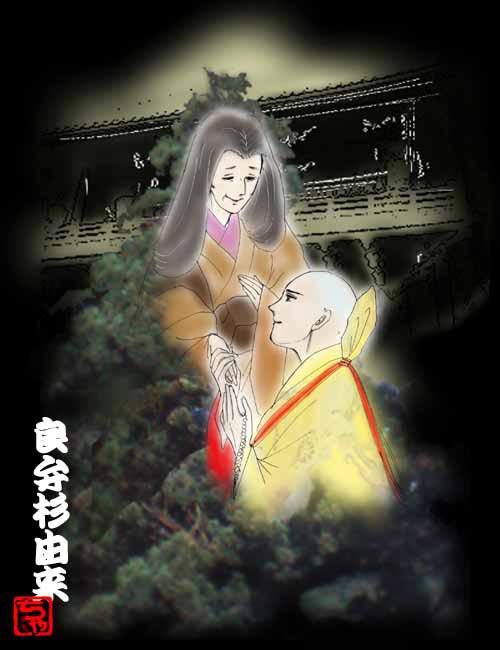| NIGATSUDď |
| Play title | R˘ben Sugi no Yurai Nigatsud˘ R˘ben Sugi no Yurai |
| Authors | Tsurusawa Dampei II (musical accompaniment) Dampei's wife Chiga (lyrics) |
| History |
The play "Nigatsud˘ R˘ben Sugi no Yurai" was originally written for the puppet theater (Bunraku) and staged for the first time in February 1887 in ďsaka at the Hikorokuza. It was adapted for Kabuki in 1898, staged in June 1898 at the Minamiza and in October 1898 at the Nakaza, starring Nakamura Ganjir˘ I and Nakamura Fukusuke III in the roles of the Priest R˘ben and his mother Nagisa-no-Kata. |
| Structure |
The current version of "Nigatsud˘ R˘ben Sugi no Yurai" is made up of 3 acts: "Shiga-no-Sato" (the Village of Shiga), "Sakura-no-Miya Monogurui" (Madness at the Sakura-no-Miya shrine) and "Nigatsud˘" (the Nigatsud˘ Hall). The third act, "Nigatsud˘", is often staged independently. |
| Key words | Gidayű Ky˘gen Jidaimono R˘ben Nigatsud˘ T˘daiji Yodogawa |
| Summary |
Shiga-no-Sato Nagisa-no-Kata, young widow of Minase Sakon, a government official, takes her infant son Mitsumaru to a tea plantation in Shiga-no-Sato for a picnic, accompanied by her nurse Saeda and maids Fujino and Harue. Remembering her visit to the tea plantation with her husband three years before, she performs a dance as she did then. Saeda takes Mitsumaru for a walk among tea plants when a huge eagle suddenly swoops upon him and carries him away. Sakura-no-Miya Monogurui Thirty years after the loss of her son, Nagisa-no-Kata, now old and reduced to poverty, wanders about the country in search of her son. Her tragic life has driven her to insanity but when she sees her reflection in the pure water of the Yodo River near the Sakura-no-Miya Shrine in ďsaka, she suddenly recovers her senses. Wishing to return to Shiga-no-Sato to pray for the repose of the soul of her son who she believes has already died, she boards a ferry on the Yodo River. On board the vessel she hears fellow passengers talk of Chief Priest R˘ben of the T˘daiji Temple in Nara who, according to them, was snatched away by an eagle from her mother as an infant. Suspecting that the eminent priest may be her son, she leaves the ferry at Hirakata and hurries toward Nara. In front of the T˘daiji Temple, Nagisa-no-Kata asks an assistant priest about Chief Priest R˘ben. The assistant priest tells her that the Chief Priest daily pays homage to the tall cryptomeria beside the Nigatsud˘ Hall into which an eagle dropped him thirty years before. He writes for her a manage on a sheet of paper about "a woman looking for her son snatched away by an eagle" and advises her to post it on the trunk of the cryptomeria in order to attract the Chief Priest's attention. On his daily visit to the cryptomeria the Chief Priest sees a notice on its trunk and, informed by his servants that a shabbily-clothed old woman who has posted it is staying near the tree, calls her to hear her story. The old woman, Nagisa-no-Kata, tells in detail how she lost her son. She says that when the infant was snatched away he had on his body a charm containing a tiny image of the Goddess of Mercy. This image R˘ben has been keeping always on his body and thus he realizes that the old woman is none other than his mother. In commemoration of their happy reunion, R˘ben decides to build a temple at his hometown. He says he will enshrine the tiny image in this temple which he will name the Ishiyama Temple. R˘ben asks his mother to stay with him in the T˘daiji Temple for a while. He respectfully escorts her to his quarters, having her carried in his palanquin. Source: Hironaga Shűzabur˘ |
 |
|
"Nigatsud˘" illustrated by ROMAN |
|
|
| Contact | Main | Top | Updates | Actors | Plays | Playwrights | Programs | Links | FAQ | Glossary | Chronology | Illustrations | Prints | Characters | Derivatives | Theaters | Coming soon | News |